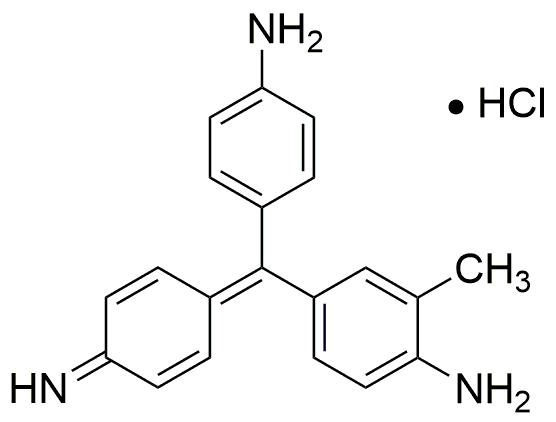Basic fuchsin is widely utilized in research focused on:
- Histology and Cytology: This dye is commonly used for staining biological tissues, allowing researchers to visualize cellular structures under a microscope. Its vivid color enhances contrast, making it easier to identify different cell types.
- Microbiology: Basic fuchsin serves as a vital stain in microbiological studies, particularly for identifying and differentiating bacteria. It is effective in highlighting certain bacterial cell walls, aiding in classification.
- Textile Industry: The compound is employed as a dye for fabrics, providing vibrant colors that are durable and resistant to fading. This application is particularly valuable for producing high-quality textiles.
- Analytical Chemistry: Basic fuchsin is used in various analytical methods, including spectrophotometry, to quantify substances in solution. Its strong absorbance properties make it a reliable choice for accurate measurements.
- Pharmaceuticals: In the pharmaceutical industry, it is used in the formulation of certain medications and as a marker in drug delivery systems, enhancing the tracking of drug distribution in biological systems.
General Information
Properties
Safety and Regulations
Applications
Basic fuchsin is widely utilized in research focused on:
- Histology and Cytology: This dye is commonly used for staining biological tissues, allowing researchers to visualize cellular structures under a microscope. Its vivid color enhances contrast, making it easier to identify different cell types.
- Microbiology: Basic fuchsin serves as a vital stain in microbiological studies, particularly for identifying and differentiating bacteria. It is effective in highlighting certain bacterial cell walls, aiding in classification.
- Textile Industry: The compound is employed as a dye for fabrics, providing vibrant colors that are durable and resistant to fading. This application is particularly valuable for producing high-quality textiles.
- Analytical Chemistry: Basic fuchsin is used in various analytical methods, including spectrophotometry, to quantify substances in solution. Its strong absorbance properties make it a reliable choice for accurate measurements.
- Pharmaceuticals: In the pharmaceutical industry, it is used in the formulation of certain medications and as a marker in drug delivery systems, enhancing the tracking of drug distribution in biological systems.
Documents
Safety Data Sheets (SDS)
The SDS provides comprehensive safety information on handling, storage, and disposal of the product.
Product Specification (PS)
The PS provides a comprehensive breakdown of the product’s properties, including chemical composition, physical state, purity, and storage requirements. It also details acceptable quality ranges and the product's intended applications.
Certificates of Analysis (COA)
Search for Certificates of Analysis (COA) by entering the products Lot Number. Lot and Batch Numbers can be found on a product’s label following the words ‘Lot’ or ‘Batch’.
*Catalog Number
*Lot Number
Certificates Of Origin (COO)
This COO confirms the country where the product was manufactured, and also details the materials and components used in it and whether it is derived from natural, synthetic, or other specific sources. This certificate may be required for customs, trade, and regulatory compliance.
*Catalog Number
*Lot Number
Safety Data Sheets (SDS)
The SDS provides comprehensive safety information on handling, storage, and disposal of the product.
DownloadProduct Specification (PS)
The PS provides a comprehensive breakdown of the product’s properties, including chemical composition, physical state, purity, and storage requirements. It also details acceptable quality ranges and the product's intended applications.
DownloadCertificates of Analysis (COA)
Search for Certificates of Analysis (COA) by entering the products Lot Number. Lot and Batch Numbers can be found on a product’s label following the words ‘Lot’ or ‘Batch’.
*Catalog Number
*Lot Number
Certificates Of Origin (COO)
This COO confirms the country where the product was manufactured, and also details the materials and components used in it and whether it is derived from natural, synthetic, or other specific sources. This certificate may be required for customs, trade, and regulatory compliance.


